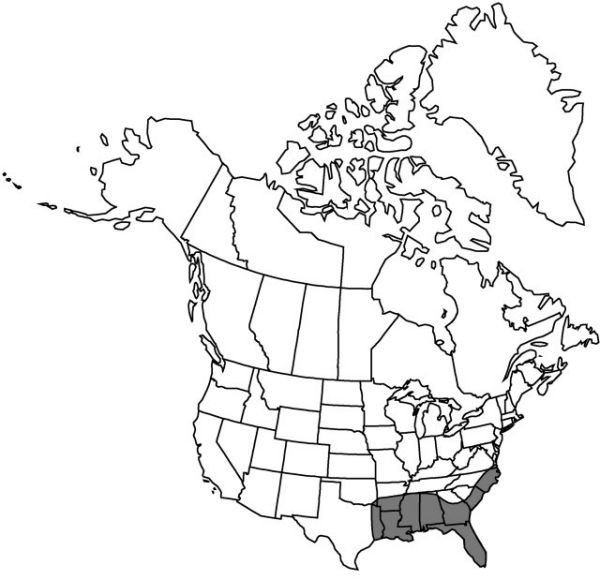Difference between revisions of "Hypoxis sessilis"
Sp. Pl. ed. 2, 1: 439. 1762.
FNA>Volume Importer |
imported>Volume Importer |
||
| (6 intermediate revisions by 2 users not shown) | |||
| Line 6: | Line 6: | ||
|place=2, 1: 439. 1762 | |place=2, 1: 439. 1762 | ||
|year=1762 | |year=1762 | ||
| + | }} | ||
| + | |special_status={{Treatment/ID/Special_status | ||
| + | |code=E | ||
| + | |label=Endemic | ||
}} | }} | ||
|basionyms= | |basionyms= | ||
| Line 11: | Line 15: | ||
|name=Hypoxis erecta var. aestivalis | |name=Hypoxis erecta var. aestivalis | ||
|authority=Engelmann & A. Gray | |authority=Engelmann & A. Gray | ||
| − | }}{{Treatment/ID/Synonym | + | |rank=variety |
| + | }} {{Treatment/ID/Synonym | ||
|name=Hypoxis longii | |name=Hypoxis longii | ||
|authority=Fernald | |authority=Fernald | ||
| + | |rank=species | ||
}} | }} | ||
|hierarchy=Liliaceae;Hypoxis;Hypoxis sessilis | |hierarchy=Liliaceae;Hypoxis;Hypoxis sessilis | ||
| Line 29: | Line 35: | ||
|elevation=0–200 m | |elevation=0–200 m | ||
|distribution=Ala.;Ark.;Fla.;Ga.;La.;Miss.;N.C.;Okla.;S.C.;Tex.;Va. | |distribution=Ala.;Ark.;Fla.;Ga.;La.;Miss.;N.C.;Okla.;S.C.;Tex.;Va. | ||
| − | |discussion=<p>Although there is a strong tendency for summer flowering in Hypoxis sessilis, in the southern part of its range it will flower at any time of year in response to fire or other disturbances.</p> | + | |discussion=<p>Although there is a strong tendency for summer flowering in <i>Hypoxis sessilis</i>, in the southern part of its range it will flower at any time of year in response to fire or other disturbances.</p> |
|tables= | |tables= | ||
|references= | |references= | ||
| Line 38: | Line 44: | ||
-->{{#Taxon: | -->{{#Taxon: | ||
name=Hypoxis sessilis | name=Hypoxis sessilis | ||
| − | |||
|authority=Linnaeus | |authority=Linnaeus | ||
|rank=species | |rank=species | ||
| Line 52: | Line 57: | ||
|publication title=Sp. Pl. ed. | |publication title=Sp. Pl. ed. | ||
|publication year=1762 | |publication year=1762 | ||
| − | |special status= | + | |special status=Endemic |
| − | |source xml=https:// | + | |source xml=https://bitbucket.org/aafc-mbb/fna-data-curation/src/2e0870ddd59836b60bcf96646a41e87ea5a5943a/coarse_grained_fna_xml/V26/V26_347.xml |
|genus=Hypoxis | |genus=Hypoxis | ||
|species=Hypoxis sessilis | |species=Hypoxis sessilis | ||
Latest revision as of 21:14, 5 November 2020
Leaves 0. 9–5 mm wide, soft, usually stiff, sparsely to densely pubescent. Scape (3–)4–9(–14) cm. Inflorescences racemose, 1(–2)-flowered; proximal 2 flowers, when present, not paired; bracts (2–)3–7(–8) mm. Flowers: tepals (6–)7–10(–13) × 0.9–2.4 mm (chasmogamous flowers), shorter to longer than pedicel, 1.5–2 times as long as ovary; anthers 1.1–2.2 mm; ovary oblanceoloid, (3–)4–5(–6) × 1.5–2.5 mm, densely pilose; pedicel (2–)3–7(–8) mm, equaling or slightly shorter than bracts. Seeds black beneath loose, iridescent, membranous coat, (1.3–)1.4–2 mm, with rounded pebbling.
Phenology: Flowering spring–summer.
Habitat: Mesic to moist pinelands
Elevation: 0–200 m
Distribution

Ala., Ark., Fla., Ga., La., Miss., N.C., Okla., S.C., Tex., Va.
Discussion
Although there is a strong tendency for summer flowering in Hypoxis sessilis, in the southern part of its range it will flower at any time of year in response to fire or other disturbances.
Selected References
None.